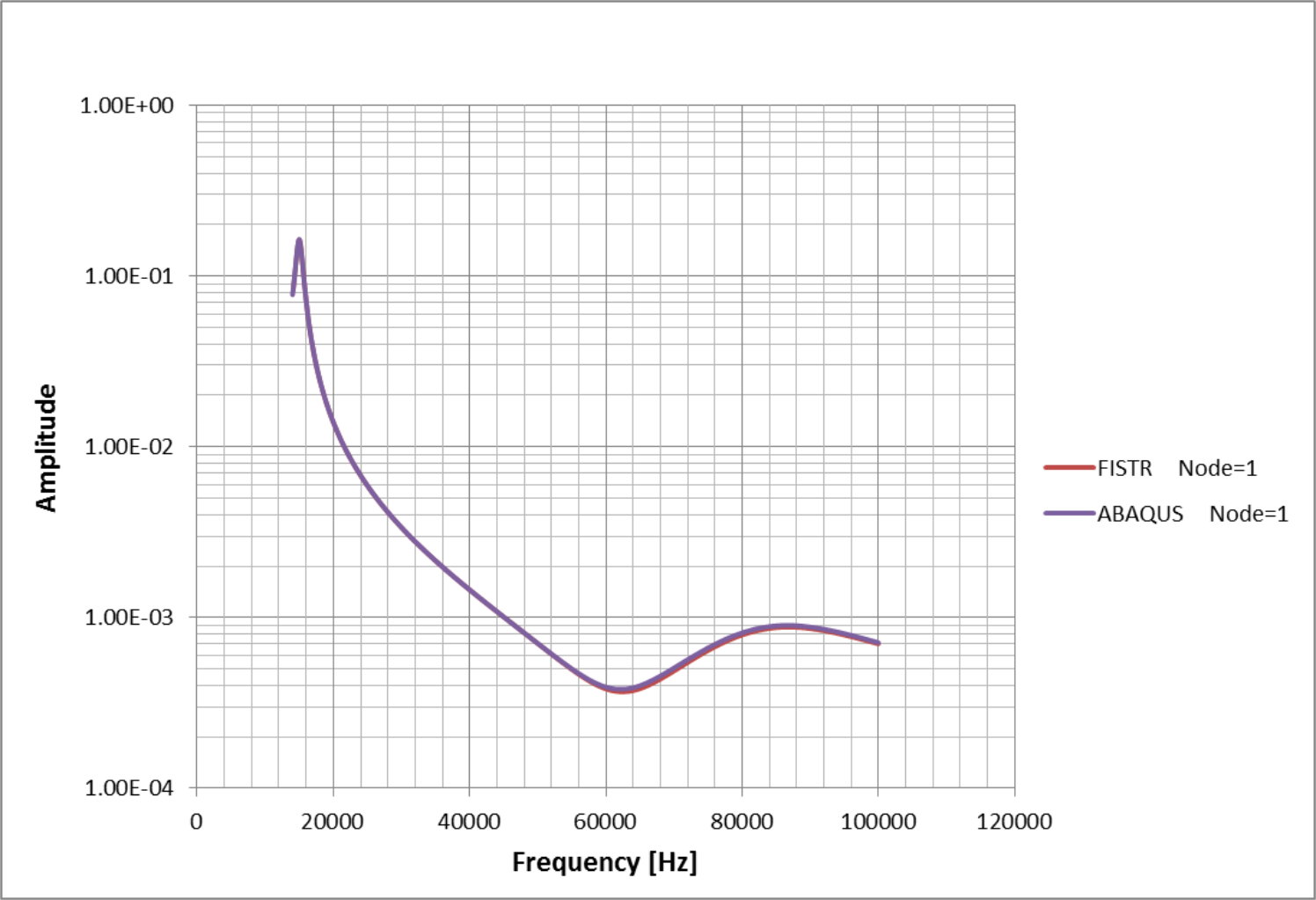Verification by Simple Geometric Model
Verification by Simple-Shaped Model
Elastic static analysis
This verification was performed with a mesh-divided cantilever, as shown in Fig. 9.1.1. The analysis was performed with seven load conditions, exA–exG, as illustrated in Fig. 9.1.2. Please note that exG has the same load conditions as those of exA using the direct method solver.
The verification result of each load condition is presented in Tables 9.1.1–9.1.7.

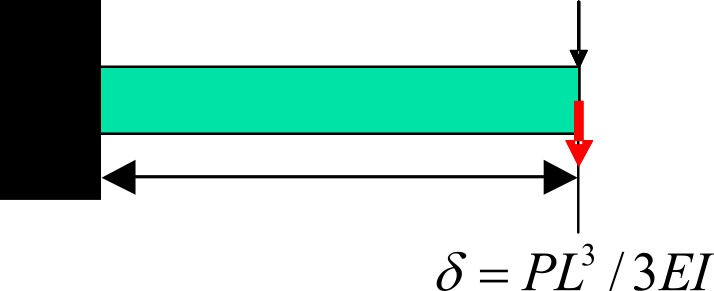 |
(a) exA, G: Concentrated load |
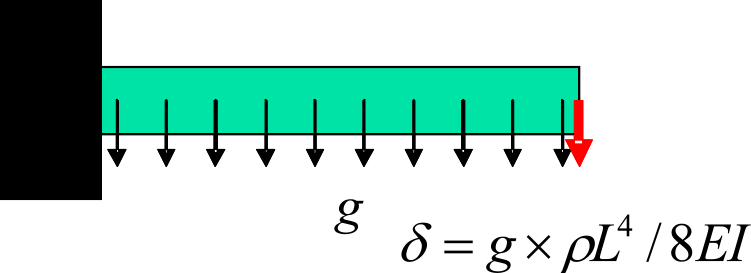 |
(b) exD: Gravitation |
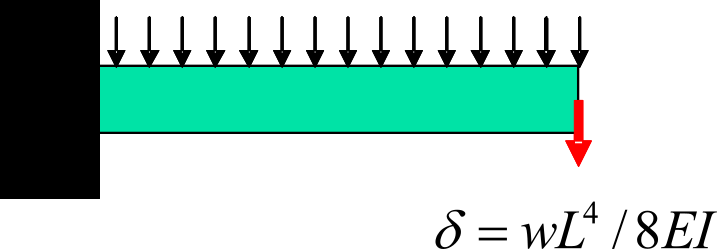 |
(c) exB: Surface-distributed load |
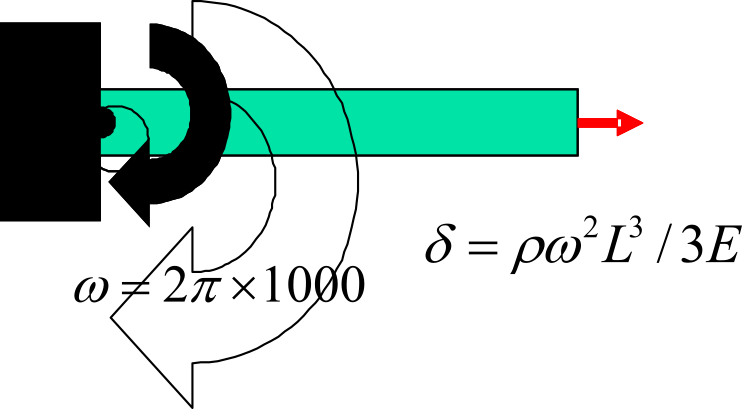 |
(d) exE: Centrifugal force |
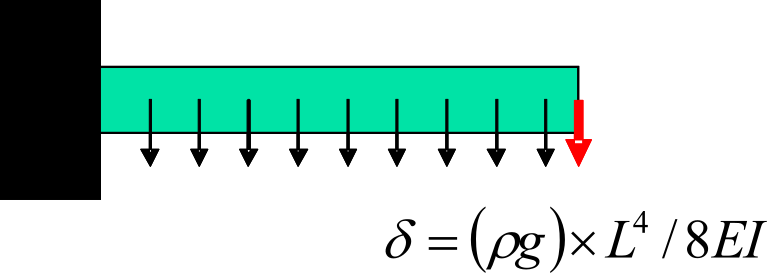 |
(e) exC: Volume load |
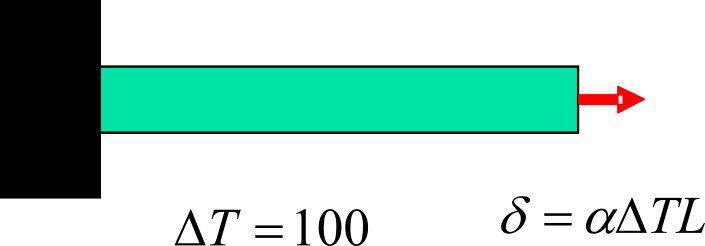 |
(f) exF : Heat load |
| Item | Value |
|---|---|
| Young's Modulus | E=4000.0 kgf/mm2 |
| Length | L=10.0 mm |
| Poisson's Ratio | ν=0.3 |
| Sectional area | A=1.0 mm2 |
| Mass density | ρ=8.0102×10−10 kgs2/mm4 |
| Second moment of area | I=1.0/12.0 mm4 |
| Gravitational acceleration | g=9800.0 mm/s2 |
| Linear coefficient of thermal expansion | α=1.0×10−5 |
| Case Name | Number of elements | Predicated Value : δmax=−1.000 | Remarks | ||
|---|---|---|---|---|---|
| NASTRAN | ABAQUS | FrontISTR | |||
| A231 | 40 | -0.338 | -0.371 | -0.371 | 33 nodes / plane stress status problem |
| A232 | 40 | -0.942 | -1.002 | -1.002 | 105 nodes / plane stress status problem |
| A241 | 20 | -0.720 | -0.711 | -0.711 | 33 nodes / plane stress status problem |
| A242 | 20 | -0.910 | -1.002 | -1.002 | 85 nodes / plane stress status problem |
| A341 | 240 | -0.384 | -0.384 | -0.386 | 99 nodes |
| A342 | 240 | -0.990 | -0.990 | -0.999 | 525 nodes |
| A351 | 80 | -0.353 | -0.355 | -0.351 | 99 nodes |
| A352 | 80 | -0.993 | -0.993 | -0.992 | 381 nodes |
| A361 | 40 | -0.954 | -0.985 | -0.984 | 99 nodes |
| A362 | 40 | -0.994 | -0.993 | -0.993 | 220 nodes |
| A731 | 40 | - | - | -0.991 | 33 nodes / direct method |
| A741 | 20 | - | - | -0.996 | 33 nodes / direct method |
| Case name | Number of elements | Predicated value : δmax=−3.750 | Remarks | ||
|---|---|---|---|---|---|
| NASTRAN | ABAQUS | FrontISTR | |||
| B231 | 40 | -1.281 | -1.403 | -1.403 | 33 nodes / plane stress status problem |
| B232 | 40 | -3.579 | -3.763 | -3.763 | 105 nodes / plane stress status problem |
| B241 | 20 | -3.198 | -2.680 | -2.680 | 33 nodes / plane stress status problem |
| B242 | 20 | -3.426 | -3.765 | -3.765 | 85 nodes / plane stress status problem |
| B341 | 240 | -1.088 | -1.449 | -1.454 | 99 nodes |
| B342 | 240 | -3.704 | -3.704 | -3.748 | 525 nodes |
| B351 | 80 | -3.547 | -1.338 | -1.325 | 99 nodes |
| B352 | 80 | -0.3717 | -3.716 | -3.713 | 381 nodes |
| B361 | 40 | -3.557 | -3.691 | -3.688 | 99 nodes |
| B362 | 40 | -3.726 | -3.717 | -3.717 | 220 nodes |
| B731 | 40 | - | - | -3.722 | 33 nodes / direct method |
| B741 | 20 | - | - | -3.743 | 33 nodes / direct method |
| Case Name | Number of elements | Predicated Value : δmax=−2.944−5 | Remarks | ||
|---|---|---|---|---|---|
| NASTRAN | ABAQUS | FrontISTR | |||
| C231 | 40 | - | -1.101e-5 | -1.101e-5 | 33 nodes / plane stress problem |
| C232 | 40 | - | -2.951e-5 | -2.951e-5 | 105 nodes / plane stress problem |
| C241 | 20 | - | -2.102e-5 | -2.102e-5 | 33 nodes / plane stress problem |
| C242 | 20 | - | -2.953e-5 | -2.953e-5 | 85 nodes / plane stress problem |
| C341 | 240 | - | -1.136e-5 | -1.140e-5 | 99 nodes |
| C342 | 240 | - | -2.905e-5 | -2.937e-5 | 525 nodes |
| C351 | 80 | - | -1.050e-5 | -1.039e-5 | 99 nodes |
| C352 | 80 | - | -2.914e-5 | -2.911e-5 | 381 nodes |
| C361 | 40 | - | -2.895e-5 | -2.893e-5 | 99 nodes |
| C362 | 40 | - | -2.915e-5 | -2.915e-5 | 220 nodes |
| C731 | 40 | - | - | -2.922e-5 | 33 nodes / direct method |
| C741 | 20 | - | - | -2.938e-5 | 33 nodes / direct method |
| Case name | Number of elements | Predicated Value : δmax=−2.944−5 | Remarks | ||
|---|---|---|---|---|---|
| NASTRAN | ABAQUS | FrontISTR | |||
| D231 | 40 | -1.101e-5 | -1.101e-5 | -1.101e-5 | 33 nodes / plane stress status problem |
| D232 | 40 | -2.805e-5 | -2.951e-5 | -2.951e-5 | 105 nodes / plane stress status problem |
| D241 | 20 | -2.508e-5 | -2.102e-5 | -2.102e-5 | 33 nodes / plane stress status problem |
| D242 | 20 | -2.684e-5 | -2.953e-5 | -2.953e-5 | 85 nodes / plane stress status problem |
| D341 | 240 | -1.172e-5 | -1.136e-5 | -1.140e-5 | 99 nodes |
| D342 | 240 | -2.906e-5 | -2.905e-5 | -2.937e-5 | 525 nodes |
| D351 | 80 | -1.046e-5 | -1.050e-5 | -1.039e-5 | 99 nodes |
| D352 | 80 | -2.917e-5 | -2.914e-5 | -2.911e-5 | 381 nodes |
| D361 | 40 | -2.800e-5 | -2.895e-5 | -2.893e-5 | 99 nodes |
| D362 | 40 | -2.919e-5 | -2.915e-5 | -2.915e-5 | 220 nodes |
| D731 | 40 | - | - | -2.922e-5 | 33 nodes / direct method |
| D741 | 20 | - | - | -2.938e-5 | 33 nodes / direct method |
| Case name | Number of elements | Predicated value : δmax=2.635−3 | Remarks | ||
|---|---|---|---|---|---|
| NASTRAN | ABAQUS | FrontISTR | |||
| E231 | 40 | 2.410e-3 | 2.616e-3 | 2.650e-3 | 33 nodes / plane stress status problem |
| E232 | 40 | 2.447e-3 | 2.627e-3 | 2.628e-3 | 105 nodes / plane stress status problem |
| E241 | 20 | 2.386e-3 | 2.622e-3 | 2.624e-3 | 33 nodes / plane stress status problem |
| E242 | 20 | 2.387e-3 | 2.627e-3 | 2.629e-3 | 85 nodes / plane stress status problem |
| E341 | 240 | 2.708e-3 | 2.579e-3 | 2.625e-3 | 99 nodes |
| E342 | 240 | 2.639e-3 | 2.614e-3 | 2.638e-3 | 525 nodes |
| E351 | 80 | 2.642e-3 | 2.598e-3 | 2.625e-3 | 99 nodes |
| E352 | 80 | 2.664e-3 | 2.617e-3 | 2.616e-3 | 381 nodes |
| E361 | 40 | 2.611e-3 | 2.603e-3 | 2.603e-3 | 99 nodes |
| E362 | 40 | 2.623e-3 | 2.616e-3 | 2.616e-3 | 220 nodes |
| E731 | 40 | - | - | 2.619e-3 | 33 nodes / direct method |
| E741 | 20 | - | - | 2.622e-3 | 33 nodes / direct method |
| Case name | Number of elements | Predicated Value : δmax=1.000−2 | Remarks | ||
|---|---|---|---|---|---|
| NASTRAN | ABAQUS | FrontISTR | |||
| F231 | 40 | - | 1.016e-2 | 1.007e-2 | 33 nodes / plane stress status problem |
| F232 | 40 | - | 1.007e-2 | 1.007e-2 | 105 nodes / plane stress status problem |
| F241 | 20 | - | 1.010e-2 | 1.010e-2 | 33 nodes / plane stress status problem |
| F242 | 20 | - | 1.006e-2 | 1.006e-2 | 85 nodes / plane stress status problem |
| F341 | 240 | - | 1.047e-2 | 1.083e-2 | 99 nodes |
| F342 | 240 | - | 1.018e-2 | 1.022e-2 | 525 nodes |
| F351 | 80 | - | 1.031e-2 | 1.062e-2 | 99 nodes |
| F352 | 80 | - | 1.015e-2 | 1.017e-2 | 381 nodes |
| F361 | 40 | - | 1.026e-2 | 1.026e-2 | 99 nodes |
| F362 | 40 | - | 1.016e-2 | 1.016e-2 | 220 nodes |
| Case name | Number of elements | Predicated value : δmax=−1.000 | Remarks | ||
|---|---|---|---|---|---|
| NASTRAN | ABAQUS | FrontISTR | |||
| G231 | 40 | -0.338 | -0.371 | -0.371 | 33 nodes / plane stress status problem |
| G232 | 40 | -0.942 | -1.002 | -1.002 | 105 nodes / plane stress status problem |
| G241 | 20 | -0.720 | -0.711 | -0.711 | 33 nodes / plane stress status problem |
| G242 | 20 | -0.910 | -1.002 | -1.002 | 85 nodes / plane stress status problem |
| G341 | 240 | -0.384 | -0.384 | -0.386 | 99 nodes |
| G342 | 240 | -0.990 | -0.990 | -0.999 | 52 nodes |
| G351 | 80 | -0.353 | -0.355 | -0.351 | 99 nodes |
| G352 | 80 | -0.993 | -0.993 | -0.992 | 381 nodes |
| G361 | 40 | -0.954 | -0.985 | -0.984 | 99 nodes |
| G362 | 40 | -0.994 | -0.993 | -0.993 | 220 nodes |
| G731 | 40 | - | - | -0.991 | 33 nodes / direct method |
| G741 | 20 | - | - | -0.996 | 33 nodes / dierct method |
Non-linear static analysis
(2-1) exnl1: Geometrical non-linear analysis
The verification model of exI is the same as those of exA–G. A schematic diagram of the verification model is shown in Fig. 9.1.3. A geometric non-linear analysis was performed on this model. The verification results are presented in Table 9.1.8.
The non-linear calculation is a ten-step process with an increment value of 0.1 P and a final load of 1.0 P.

| Case Name | 0.1 | 0.2 | 0.3 | 0.4 | 0.5 | 0.6 | 0.7 | 0.8 | 0.9 | 1.0 | Linear Solution |
|---|---|---|---|---|---|---|---|---|---|---|---|
| I231 | - | - | - | - | - | - | - | - | - | - | - |
| I232 | - | - | - | - | - | - | - | - | - | - | - |
| I241 | - | - | - | - | - | - | - | - | - | - | - |
| I242 | - | - | - | - | - | - | - | - | - | - | - |
| I341 | 0.039 | 0.077 | 0.116 | 0.154 | 0.193 | 0.232 | 0.270 | 0.309 | 0.348 | 0.386 | 0.386 |
| I342 | 0.099 | 0.200 | 0.300 | 0.400 | 0.499 | 0.599 | 0.698 | 0.797 | 0.896 | 0.995 | 0.999 |
| I351 | 0.035 | 0.070 | 0.105 | 0.141 | 0.176 | 0.211 | 0.246 | 0.281 | 0.316 | 0.351 | 0.351 |
| I352 | 0.099 | 0.198 | 0.298 | 0.397 | 0.496 | 0.595 | 0.693 | 0.792 | 0.890 | 0.987 | 0.992 |
| I361 | 0.070 | 0.139 | 0.209 | 0.278 | 0.348 | 0.417 | 0.487 | 0.556 | 0.625 | 0.694 | 0.984 |
| I362 | 0.099 | 0.197 | 0.298 | 0.397 | 0.496 | 0.595 | 0.694 | 0.793 | 0.891 | 0.988 | 0.993 |
(2-2) exnl2: Elastoplasticity deformation analysis
Based on the test conducted at National Agency for Finite Element Methods and Standards (NAFEMS; U.K.): Test NL1, this verification problem was verified by elastoplastic deformation analysis that incorporated geometric non-linearity and multiple hardening rules. The elastoplastic deformation analysis model is shown in Fig. 9.1.4.

(1) Verification conditions:
| Item | Value |
|---|---|
| Material | Mises elastoplastic material |
| Young's Modulus | E=250GPa |
| Poisson's Ratio | ν=0.25 |
| Initial yield stress | 5MPa |
| Initial yield strain | 0.25×10−4 |
| Isotropic hardening factor | Hi=0 or 62.5GPa |
(2) Boundary conditions
| Item | Boundary conditions | Value |
|---|---|---|
| step 1 | Forced displacement in nodes 2 and 3 | ux=0.2500031251∗10−4 |
| step 2 | Forced displacement in nodes 2 and 3 | ux=0.25000937518∗10−4 |
| step 3 | Forced displacement in nodes 3 and 4 | uy=0.2500031251∗10−4 |
| step 4 | Forced displacement in nodes 3 and 4 | uy=0.25000937518∗10−4 |
| step 5 | Forced displacement in nodes 2 and 3 | ux=−0.25000937518∗10−4 |
| step 6 | Forced displacement in nodes 2 and 3 | ux=−0.2500031251∗10−4 |
| step 7 | Forced displacement in nodes 3 and 4 | uy=−0.25000937518∗10−4 |
| step 8 | Forced displacement in nodes 3 and 4 | uy=−0.2500031251∗10−4 |
All the nodes that are not mentioned here are fully constrained. The theoretical solution for this problem is presented as follows:
| Strain (×10−4) [εx, εy, εz] |
Equivalent Stress (MPa) [Hi=0 Hk=0; Hi=62.5 Hk=0] |
|---|---|
| 0.25, 0, 0 | 5.0; 5.0 |
| 0.50, 0, 0 | 5.0; 5.862 |
| 0.50, 0.25, 0 | 5.0; 5.482 |
| 0.50, 0.50, 0 | 5.0; 6.362 |
| 0.25, 0.50, 0 | 5.0; 6.640 |
| 0, 0.50, 0 | 5.0; 7.322 |
| 0, 0.25, 0 | 3.917; 4.230 |
| 0, 0, 0 | 5.0; 5.673 |
The results of the calculations are as follows:
| Strain (×10−4) [εx, εy, εz] |
Equivalent Stress (MPa) [Hi=0 Hk=0; Hi=62.5 Hk=0] |
|---|---|
| 0.25, 0, 0 | 5.0 (0.0%); 5.0 (0.0%) |
| 0.50, 0, 0 | 5.0 (0.0%); 5.862 (0.0%) |
| 0.50, 0.25, 0 | 5.0 (0.0%); 5.482 (0.0%) |
| 0.50, 0.50, 0 | 5.0 (0.0%); 6.362 (-0.05%) |
| 0.25, 0.50, 0 | 5.0 (0.0%); 6.640 (-0.21%) |
| 0, 0.50, 0 | 5.0 (0.0%); 7.322 (-0.34%) |
| 0, 0.25, 0 | 3.824 (-2.4%); 4.230 (-2.70%) |
| 0, 0, 0 | 5.0 (0.0%); 5.673 (5.673 (-2.50%) |
Contact analysis (1)
Based on the contact patch test problem (CGS-4) from NAFEMS (U.K.), this verification problem tests the finite sliding contact problem function with friction. The contact analysis model is shown in Fig. 9.1.5
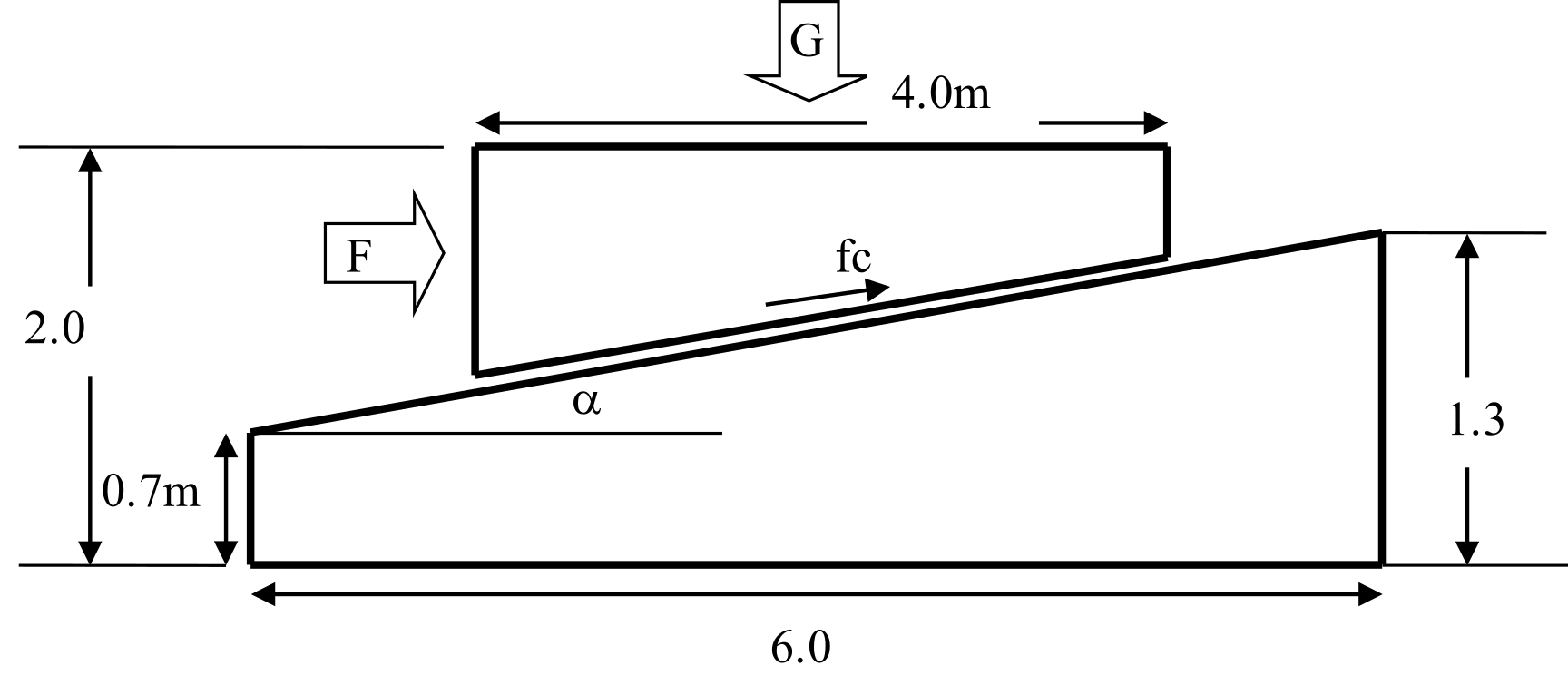
The equilibrium condition of this problem is as follows:
Fcosα−Gsinα=±fc
In the adhesive friction stage, the frictional force is as follows:
fc=EtΔu
In the sliding friction stage, the frictional force is as follows:
fc=μ(Gcosα+Fsinα)
The comparison between the calculation results and the analysis solution is as follows.
| μ | F/G Analysis Solution | F/G Calculation Results |
|---|---|---|
| 0.0 | 0.1 | 0.1 |
| 0.1 | 0.202 | 0.202 |
| 0.2 | 0.306 | 0.306 |
| 0.3 | 0.412 | 0.412 |
Contact analysis (2): Hertz contact problem
In this verification, the Hertz contact problem between a cylinder of infinite length and an infinite plane was analyzed. The cylinder’s radius was R=8 mm, and the deformable body’s Young’s modulus E and Poisson’s ratio µ were 1100 MPa and 0.0, respectively. Moreover, assuming that the contact area was much smaller than the cylinder’s radius, and also considering the symmetry of the problem, the analysis was performed with a quarter model of the cylinder.
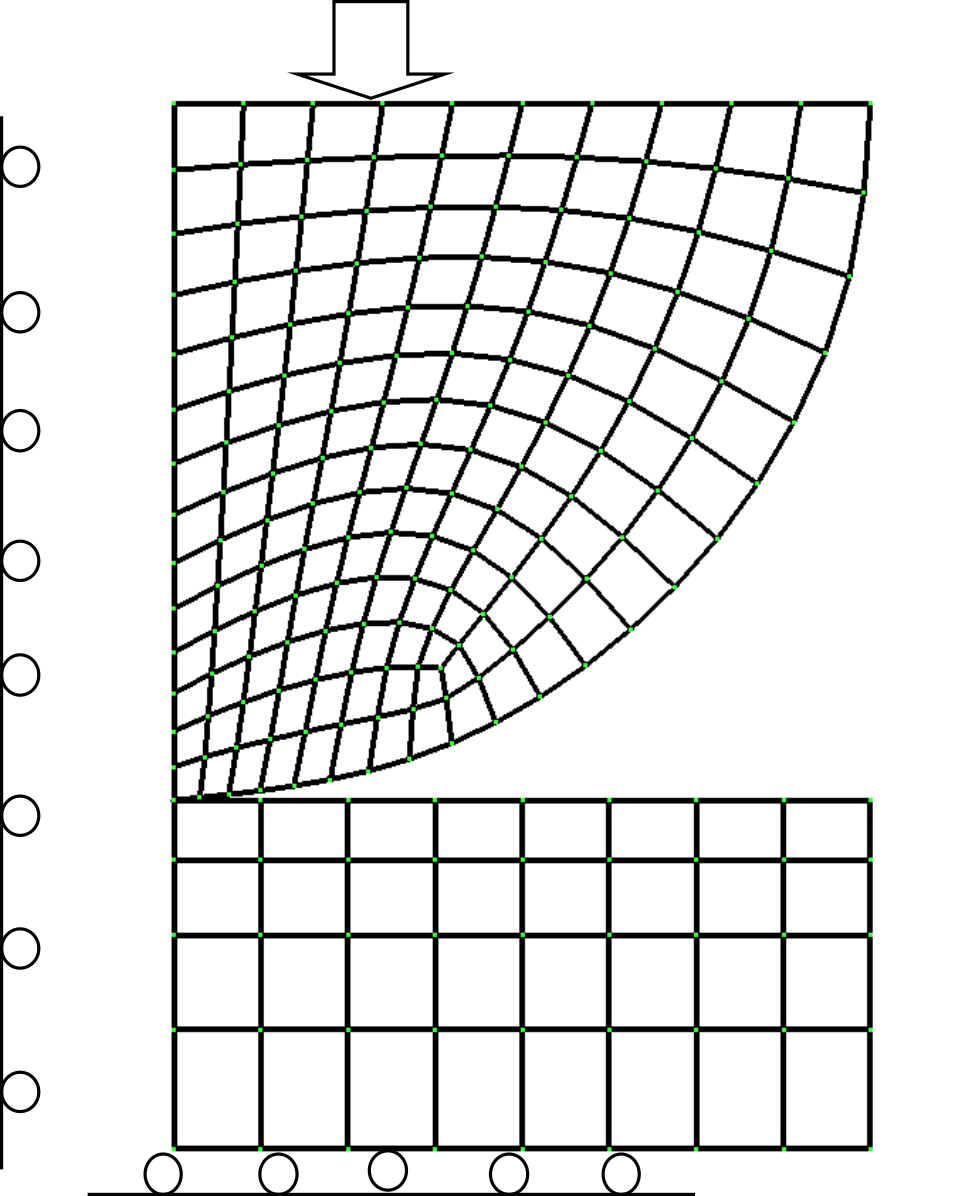
(1) Verification results of contact radius
The theoretical formula to calculate the contact radius is as follows:
a=√4FRπE∗
where
E∗=E2(1−μ2)
With the actual calculation, when the pressure is F=100, the contact radius is a=1.36.
Fig. 9.1.7 shows the equivalent nodal force of the contact point. The contact radius is obtained by extrapolating this nodal force distribution.
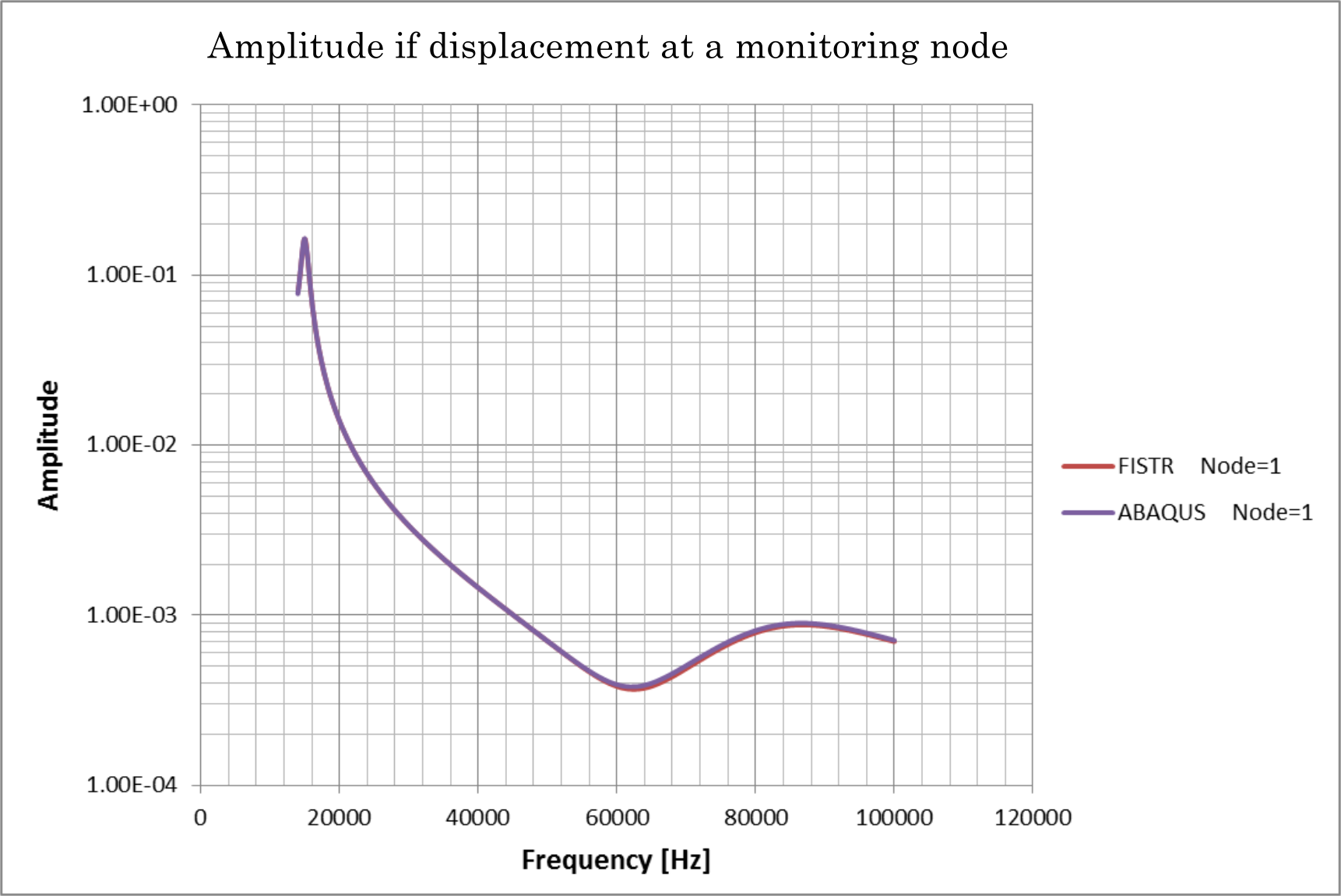
(2) Verification results of maximum shear stress
With the theoretical solution, when the contact position is z=0.78a, the maximum shear stress is as follows:
τmax=0.30√FE∗πR
With the actual calculation conditions, it becomes
τmax=14.2
The actual result obtained was
τmax=15.6
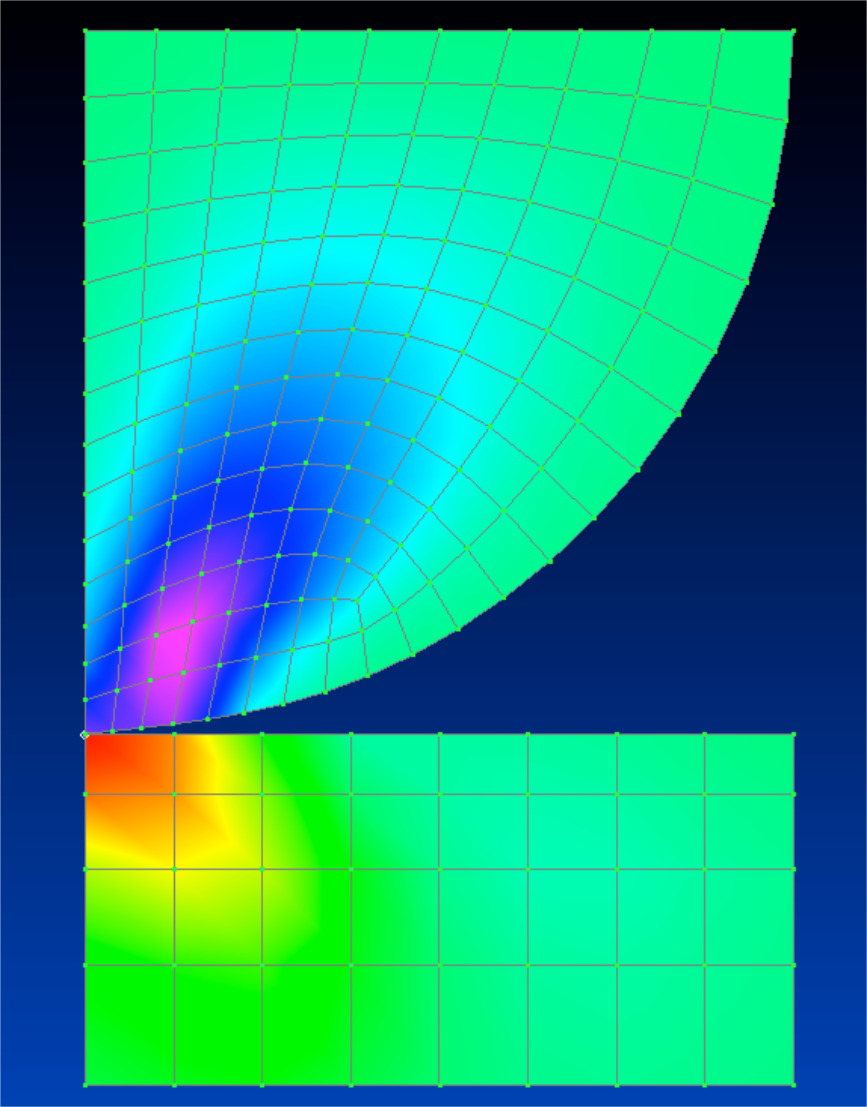
(3) Eigenvalue analysis
The verification models of exJ and exK are the same as those of exA–G. A schematic diagram of the verification model is shown in Fig. 9.1.9. An eigenvalue analysis was performed for this model to determine the primary, secondary, and tertiary eigenvalues. The iteration and direct method solvers were used for exJ and exK, respectively. Furthermore, the verification results are presented in Tables 9.1.9–9.1.12.

The vibration eigenvalue of the cantilever is determined by the following equations:
Primary : n1=1.87522πl2√gEIω
Secondary : n2=4.69422πl2√gEIω
Tertiary : n3=7.85522πl2√gEIω
The property values of the verification model are:
| Item | Value |
|---|---|
| I | 10.0mm |
| E | 4000.0kgf/mm2 |
| l | 1.0/12.0mm4 |
| ω | 7.85∗10−6kgf/mm3 |
| g | 9800.0mm/sec2 |
Therefore, the primary to tertiary eigenvalue are as follows:
| Mode number | Value |
|---|---|
| n1 | 3.609e3 |
| n2 | 2.262e4 |
| n3 | 6.335e4 |
| Case Name | Number of elements | Predicated value : n1=3.609e3 | Remarks | |
|---|---|---|---|---|
| NASTRAN | FrontISTR | |||
| J231 | 40 | 5.861e3 | 5.861e3 | 33 nodes / plane stress status problem |
| J232 | 40 | 3.596e3 | 3.593e3 | 105 nodes / plane stress status problem |
| J241 | 20 | 3.586e3 | 4.245e3 | 33 nodes / plane stress status problem |
| J242 | 20 | 3.590e3 | 3.587e3 | 85 nodes / plane stress status problem |
| J341 | 240 | 5.442e3 | 5.429e3 | 99 nodes |
| J342 | 240 | 3.621e3 | 3.595e3 | 525 nodes |
| J351 | 80 | 3.695e3 | 4.298e3 | 99 nodes |
| J352 | 80 | 3.610e3 | 3.609e3 | 381 nodes |
| J361 | 40 | 3.679e3 | 3.619e3 | 99 nodes |
| J362 | 40 | 3.611e3 | 3.606e3 | 220 nodes |
| Case name | Number of elements | Predicated value : n2=2.262e4 | Remarks | |
|---|---|---|---|---|
| NASTRAN | FrontISTR | |||
| J231 | 40 | 3.350e4 | 3.351e4 | 33 nodes / plane stress status problem |
| J232 | 40 | 2.163e4 | 2.156e4 | 105 nodes / plane stress status problem |
| J241 | 20 | 2.149e4 | 2.516e4 | 33 nodes / plane stress status problem |
| J242 | 20 | 2.149e4 | 2.143e4 | 85 nodes / plane stress status problem |
| J341 | 240 | 3.145e4 | 3.138e4 | 99 nodes |
| J342 | 240 | 2.171e4 | 2.155e4 | 525 nodes |
| J351 | 80 | 2.208e4 | 2.546e4 | 99 nodes |
| J352 | 80 | 2.156e4 | 2.149e4 | 381 nodes |
| J361 | 40 | 2.202e4 | 2.168e4 | 99 nodes |
| J362 | 40 | 2.154e4 | 2.144e4 | 220 nodes |
Note: In the three-dimensional (3D) models, the primary and secondary values have equal roots. Therefore, the secondary value in the table represents the tertiary calculation value.
| Case name | Number of elements | Predicated Value : n1=3.609e3 | Remarks | |
|---|---|---|---|---|
| NASTRAN | FrontISTR | |||
| J231 | 40 | 5.861e3 | 5.861e3 | 33 nodes / plane stress status problem |
| J232 | 40 | 3.596e3 | 3.593e3 | 105 nodes / plane stress status problem |
| J241 | 20 | 3.586e3 | 4.245e3 | 33 nodes / plane stress status problem |
| J242 | 20 | 3.590e3 | 3.587e3 | 85 nodes / plane stress status problem |
| J341 | 240 | 5.442e3 | 5.429e3 | 99 nodes |
| J342 | 240 | 3.621e3 | 3.595e3 | 525 nodes |
| J351 | 80 | 3.695e3 | 4.298e3 | 99 nodes |
| J352 | 80 | 3.610e3 | 3.609e3 | 381 nodes |
| J361 | 40 | 3.679e3 | 3.619e3 | 99 nodes |
| J362 | 40 | 3.611e3 | 3.606e3 | 220 nodes |
| J731 | 40 | - | 3.606e3 | 220 nodes |
| J741 | 20 | - | 3.594e3 | 220 nodes |
| Case name | Number of elements | Predicated value : n2=2.262e4 | Remarks | |
|---|---|---|---|---|
| NASTRAN | FrontISTR | |||
| J231 | 40 | 3.350e4 | 3.351e4 | 33 nodes / plane stress status problem |
| J232 | 40 | 2.163e4 | 2.156e4 | 105 nodes / plane stress status problem |
| J241 | 20 | 2.149e4 | 2.516e4 | 33 nodes / plane stress status problem |
| J242 | 20 | 2.149e4 | 2.143e4 | 85 nodes / plane stress status problem |
| J341 | 240 | 3.145e4 | 3.138e4 | 99 nodes |
| J342 | 240 | 2.171e4 | 2.155e4 | 525 nodes |
| J351 | 80 | 2.208e4 | 2.546e4 | 99 nodes |
| J352 | 80 | 2.156e4 | 2.149e4 | 381 nodes |
| J361 | 40 | 2.202e4 | 2.168e4 | 99 nodes |
| J362 | 40 | 2.154e4 | 2.144e4 | 220 nodes |
| J731 | 40 | - | 2.156e4 | 220 nodes |
| J741 | 20 | - | 2.153e4 | 220 nodes |
Note: In the 3D models, the primary and secondary values have equal roots. Therefore, the secondary value in the table represents the tertiary calculation value.
(4) Heat conduction analysis
The common conditions for the steady-state heat conduction analysis are shown in Fig. 9.1.10. The individual conditions for the verification cases exM–exT are shown in Fig. 9.1.11. The mesh division used here is equivalent to that of exA.
The verification results (temperature distribution table) of each case are presented in Tables 9.1.13–9.1.20.

| Length between AB | L=10.0m |
| Cross-sectional area | A=1.0mm2 |
Temperature dependency of thermal conductivity
| Thermal conductivity λ(W/mK) | Temperature (∘C) |
|---|---|
| 50.0 | 0.0 |
| 35.0 | 500.0 |
| 20.0 | 1000.0 |
| exM: Linear material | |
| exN: Specified tempreature problem |  |
| exO: Concentrated heat flux problem |  |
| exP: Distributed heat flux problem |  |
| exQ: Convective heat transfer problem |  |
| exR: Radiant heat transfer problem |  |
| exS: Volume heat generation problem |  |
| exT: Internal gap problem |  |
| Case name | Element type | Number of elements/nodes | Distance from edge A (m) | ||||||
|---|---|---|---|---|---|---|---|---|---|
| Edge A | 2.0 | 4.0 | 6.0 | 8,0 | Edge B | ||||
| M361A | 361 | 40/33 | 0.0 | 100.0 | 200.0 | 300.0 | 400.0 | 500.0 | |
| M361B | 361 | 40/105 | 0.0 | 100.0 | 200.0 | 300.0 | 400.0 | 500.0 | |
| M361C | 361 | 20/33 | 0.0 | 100.0 | 200.0 | 300.0 | 400.0 | 500.0 | |
| M361D | 361 | 20/85 | 0.0 | 100.0 | 200.0 | 300.0 | 400.0 | 500.0 | |
| M361E | 361 | 240/99 | 0.0 | 100.0 | 200.0 | 300.0 | 400.0 | 500.0 | |
| M361F | 361 | 24/525 | 0.0 | 100.0 | 200.0 | 300.0 | 400.0 | 500.0 | |
| M361G | 361 | 80/99 | 0.0 | 100.0 | 200.0 | 300.0 | 400.0 | 500.0 |
| Case name | Element type | Number of elements/nodes | Distance from edge A (m) | ||||||
|---|---|---|---|---|---|---|---|---|---|
| Edge A | 2.0 | 4.0 | 6.0 | 8,0 | Edge B | ||||
| ABAQUS | 361 | 40/99 | 0.0 | 87.3 | 179.7 | 278.2 | 384.3 | 500.0 | |
| N231 | 231 | 40/33 | 0.0 | 87.2 | 179.5 | 278.0 | 384.1 | 500.0 | |
| N232 | 232 | 40/105 | 0.0 | 86.0 | 178.3 | 276.8 | 382.9 | 500.0 | |
| N241 | 241 | 20/33 | 0.0 | 87.3 | 179.7 | 278.2 | 384.3 | 500.0 | |
| N242 | 242 | 20/85 | 0.0 | 87.3 | 179.7 | 278.2 | 384.3 | 500.0 | |
| N341 | 341 | 240/99 | 0.0 | 87.3 | 179.7 | 278.2 | 384.3 | 500.0 | |
| N342 | 342 | 24/525 | 0.0 | 87.9 | 179.9 | 278.0 | 383.6 | 500.0 | |
| N351 | 351 | 80/99 | 0.0 | 87.3 | 179.7 | 278.2 | 384.3 | 500.0 | |
| N352 | 352 | 80/381 | 0.0 | 87.3 | 179.7 | 278.2 | 384.3 | 500.0 | |
| N361 | 361 | 40/99 | 0.0 | 87.3 | 179.7 | 278.2 | 384.3 | 500.0 | |
| N362 | 362 | 40/330 | 0.0 | 87.3 | 179.7 | 278.2 | 384.3 | 500.0 | |
| N731 | 731 | 40/33 | 0.0 | 87.3 | 179.7 | 278.2 | 384.3 | 500.0 | |
| N741 | 741 | 20/33 | 0.0 | 87.3 | 179.7 | 278.2 | 384.3 | 500.0 |
| Case name | Element type | Numbewr of elements/nodes | Distance from edge A (m) | ||||||
|---|---|---|---|---|---|---|---|---|---|
| Edge A | 2.0 | 4.0 | 6.0 | 8,0 | Edge B | ||||
| ABAQUS | 361 | 40/99 | 0.0 | 103.2 | 213.7 | 333.3 | 464.8 | 612.6 | |
| O231 | 231 | 40/33 | 0.0 | 103.2 | 213.7 | 333.3 | 464.8 | 612.6 | |
| O232 | 232 | 40/105 | 0.0 | 103.2 | 213.7 | 333.3 | 464.8 | 612.6 | |
| O241 | 241 | 20/33 | 0.0 | 103.2 | 213.7 | 333.3 | 464.8 | 612.6 | |
| O242 | 242 | 20/85 | 0.0 | 103.2 | 213.7 | 333.4 | 465.2 | 618.0 | |
| O341 | 341 | 240/99 | - | - | - | - | - | - | |
| O342 | 342 | 24/525 | 0.0 | 104.4 | 214.9 | 334.7 | 466.3 | 614.6 | |
| O351 | 351 | 80/99 | - | - | - | - | - | - | |
| O352 | 352 | 80/381 | 0.0 | 103.2 | 213.7 | 333.3 | 465.0 | 624.2 | |
| O361 | 361 | 40/99 | 0.0 | 103.2 | 213.7 | 333.3 | 464.8 | 612.6 | |
| O362 | 362 | 40/330 | 0.0 | 103.2 | 213.7 | 333.4 | 465.5 | 623.5 | |
| O731 | 731 | 40/33 | 0.0 | 103.2 | 213.7 | 333.3 | 464.8 | 612.5 | |
| O741 | 741 | 20/33 | 0.0 | 103.2 | 213.7 | 333.3 | 464.8 | 612.6 |
| Case name | Element type | Number of elements/nodes | Distance from edge A (m) | ||||||
|---|---|---|---|---|---|---|---|---|---|
| Edge A | 2.0 | 4.0 | 6.0 | 8,0 | Edge B | ||||
| ABAQUS | 361 | 40/99 | 0.0 | 103.2 | 213.7 | 333.3 | 464.8 | 612.6 | |
| P231 | 231 | 40/33 | 0.0 | 103.2 | 213.7 | 333.3 | 464.8 | 612.6 | |
| P232 | 232 | 40/105 | 0.0 | 103.2 | 213.7 | 333.3 | 464.8 | 612.6 | |
| P241 | 241 | 20/33 | 0.0 | 103.2 | 213.7 | 333.3 | 464.8 | 612.6 | |
| P242 | 242 | 20/85 | 0.0 | 103.2 | 213.7 | 333.3 | 464.8 | 612.6 | |
| P341 | 341 | 240/99 | - | - | - | - | - | - | |
| P342 | 342 | 24/525 | 0.0 | 103.2 | 213.7 | 333.3 | 464.8 | 612.6 | |
| P351 | 351 | 80/99 | - | - | - | - | - | - | |
| P352 | 352 | 80/381 | 0.0 | 103.2 | 213.7 | 333.3 | 464.8 | 612.6 | |
| P361 | 361 | 40/99 | 0.0 | 103.2 | 213.7 | 333.3 | 464.8 | 612.6 | |
| P362 | 362 | 40/330 | 0.0 | 103.2 | 213.7 | 333.4 | 465.5 | 612.6 | |
| P731 | 731 | 40/33 | 0.0 | 103.2 | 213.7 | 333.3 | 464.8 | 612.5 | |
| P741 | 741 | 20/33 | 0.0 | 103.2 | 213.7 | 333.3 | 464.8 | 612.6 |
| Case name | Element type | Number of elements/nodes | Distance from edge A (m) | ||||||
|---|---|---|---|---|---|---|---|---|---|
| Edge A | 2.0 | 4.0 | 6.0 | 8,0 | Edge B | ||||
| ABAQUS | 361 | 40/99 | 0.0 | 89.2 | 183.8 | 284.8 | 393.9 | 513.2 | |
| Q231 | 231 | 40/33 | 0.0 | 89.2 | 183.8 | 284.8 | 393.9 | 513.2 | |
| Q232 | 232 | 40/105 | 0.0 | 89.2 | 183.8 | 284.8 | 393.9 | 513.2 | |
| Q241 | 241 | 20/33 | 0.0 | 89.2 | 183.8 | 284.8 | 393.9 | 513.2 | |
| Q242 | 242 | 20/85 | 0.0 | 89.2 | 183.8 | 284.8 | 393.9 | 513.2 | |
| Q341 | 341 | 240/99 | - | - | - | - | - | - | |
| Q342 | 342 | 24/525 | 0.0 | 89.2 | 183.8 | 284.8 | 393.9 | 513.2 | |
| Q351 | 351 | 80/99 | - | - | - | - | - | - | |
| Q352 | 352 | 80/381 | 0.0 | 89.2 | 183.8 | 284.8 | 393.9 | 513.2 | |
| Q361 | 361 | 40/99 | 0.0 | 89.2 | 183.8 | 284.8 | 393.9 | 513.2 | |
| Q362 | 362 | 40/330 | 0.0 | 89.2 | 183.8 | 284.8 | 393.9 | 513.2 | |
| Q731 | 731 | 40/33 | 0.0 | 89.2 | 183.8 | 284.8 | 393.9 | 513.2 | |
| Q741 | 741 | 20/33 | 0.0 | 89.2 | 183.8 | 284.8 | 393.9 | 513.2 |
| Case name | Element type | Number of elements/nodes | Distance from edge A (m) | ||||||
|---|---|---|---|---|---|---|---|---|---|
| Edge A | 2.0 | 4.0 | 6.0 | 8,0 | Edge B | ||||
| ABAQUS | 361 | 40/99 | 0.0 | 89.5 | 184.4 | 285.8 | 395.3 | 515.2 | |
| R231 | 231 | 40/33 | 0.0 | 89.5 | 184.4 | 285.8 | 395.3 | 515.2 | |
| R232 | 232 | 40/105 | 0.0 | 89.5 | 184.4 | 285.8 | 395.3 | 515.2 | |
| R241 | 241 | 20/33 | 0.0 | 89.5 | 184.4 | 285.8 | 395.3 | 515.2 | |
| R242 | 242 | 20/85 | 0.0 | 89.5 | 184.4 | 285.8 | 395.3 | 515.2 | |
| R341 | 341 | 240/99 | - | - | - | - | - | - | |
| R342 | 342 | 24/525 | 0.0 | 89.5 | 184.4 | 285.8 | 395.3 | 515.2 | |
| R351 | 351 | 80/99 | - | - | - | - | - | - | |
| R352 | 352 | 80/381 | 0.0 | 89.5 | 184.4 | 285.8 | 395.3 | 515.2 | |
| R361 | 361 | 40/99 | 0.0 | 89.5 | 184.4 | 285.8 | 395.3 | 515.2 | |
| R362 | 362 | 40/330 | 0.0 | 89.5 | 184.4 | 285.8 | 395.3 | 515.2 | |
| R731 | 731 | 40/33 | 0.0 | 89.5 | 184.4 | 285.8 | 395.3 | 515.2 | |
| R741 | 741 | 20/33 | 0.0 | 89.5 | 184.4 | 285.8 | 395.3 | 515.2 |
| Case name | Element type | Number of elements/nodes | Distance from edge A (m) | ||||||
|---|---|---|---|---|---|---|---|---|---|
| Edge A | 2.0 | 4.0 | 6.0 | 8,0 | Edge B | ||||
| ABAQUS | 361 | 40/99 | 0.0 | 103.2 | 213.7 | 333.3 | 464.8 | 612.6 | |
| S231 | 231 | 40/33 | 0.0 | 103.2 | 213.7 | 333.3 | 464.8 | 612.6 | |
| S232 | 232 | 40/105 | 0.0 | 103.2 | 213.7 | 333.3 | 464.8 | 612.6 | |
| S241 | 241 | 20/33 | 0.0 | 103.2 | 213.7 | 333.3 | 464.8 | 612.6 | |
| S242 | 242 | 20/85 | 0.0 | 103.2 | 213.7 | 333.3 | 464.8 | 612.6 | |
| S341 | 341 | 240/99 | - | - | - | - | - | - | |
| S342 | 342 | 24/525 | 0.0 | 103.2 | 213.7 | 333.3 | 464.8 | 612.6 | |
| S351 | 351 | 80/99 | - | - | - | - | - | - | |
| S352 | 352 | 80/381 | 0.0 | 103.2 | 213.7 | 333.3 | 464.8 | 612.6 | |
| S361 | 361 | 40/99 | 0.0 | 103.2 | 213.7 | 333.3 | 464.8 | 612.6 | |
| S362 | 362 | 40/330 | 0.0 | 103.2 | 213.7 | 333.3 | 464.8 | 612.6 | |
| S731 | 731 | 40/33 | 0.0 | 103.2 | 213.7 | 333.3 | 464.8 | 612.6 | |
| S741 | 741 | 20/33 | 0.0 | 103.2 | 213.7 | 333.3 | 464.8 | 612.6 |
| Case name | Element type | Number of elements/nodes | Distance from edge A (m) | ||||||
|---|---|---|---|---|---|---|---|---|---|
| Edge A | 2.0 | 4.0 | 6.0 | 8,0 | Edge B | ||||
| ABAQUS | 361 | 40/99 | 0.0 | 88.6 | 182.4 | 282.6 | 387.7 | 500.0 | |
| S231 | 231 | 40/33 | 0.0 | 88.6 | 182.4 | 282.6 | 387.7 | 500.0 | |
| S232 | 232 | 40/105 | 0.0 | 88.6 | 182.4 | 282.6 | 387.7 | 500.0 | |
| S241 | 241 | 20/33 | 0.0 | 88.6 | 182.4 | 282.6 | 387.7 | 500.0 | |
| S242 | 242 | 20/85 | 0.0 | 88.6 | 182.4 | 282.6 | 387.7 | 500.0 | |
| S341 | 341 | 240/99 | - | - | - | - | - | - | |
| S342 | 342 | 24/525 | 0.0 | 88.6 | 182.4 | 282.6 | 387.7 | 500.0 | |
| S351 | 351 | 80/99 | - | - | - | - | - | - | |
| S352 | 352 | 80/381 | 0.0 | 88.6 | 182.4 | 282.6 | 387.7 | 500.0 | |
| S361 | 361 | 40/99 | 0.0 | 88.6 | 182.4 | 282.6 | 387.7 | 500.0 | |
| S362 | 362 | 40/330 | 0.0 | 88.6 | 182.4 | 282.6 | 387.7 | 500.0 | |
| S731 | 731 | 40/33 | 0.0 | 88.6 | 182.4 | 282.6 | 387.7 | 500.0 | |
| S741 | 741 | 20/33 | 0.0 | 88.6 | 182.4 | 282.6 | 387.7 | 500.0 |
(5) Linear dynamic analysis
In exW, a linear dynamic analysis was performed on the same mesh-divided cantilever that was discussed earlier in the Elastic static analysis subsection, with the verification conditions shown in Fig. 9.1.12. The objective was to verify the impact of time increment on the results with the same mesh division. Both the implicit and explicit methods of dynamic analysis and the element types 361 and 342 were used. The verification results are presented in Table 9.1.22 and shown in Figs. 9.1.13–9.1.15.
Analysis Model

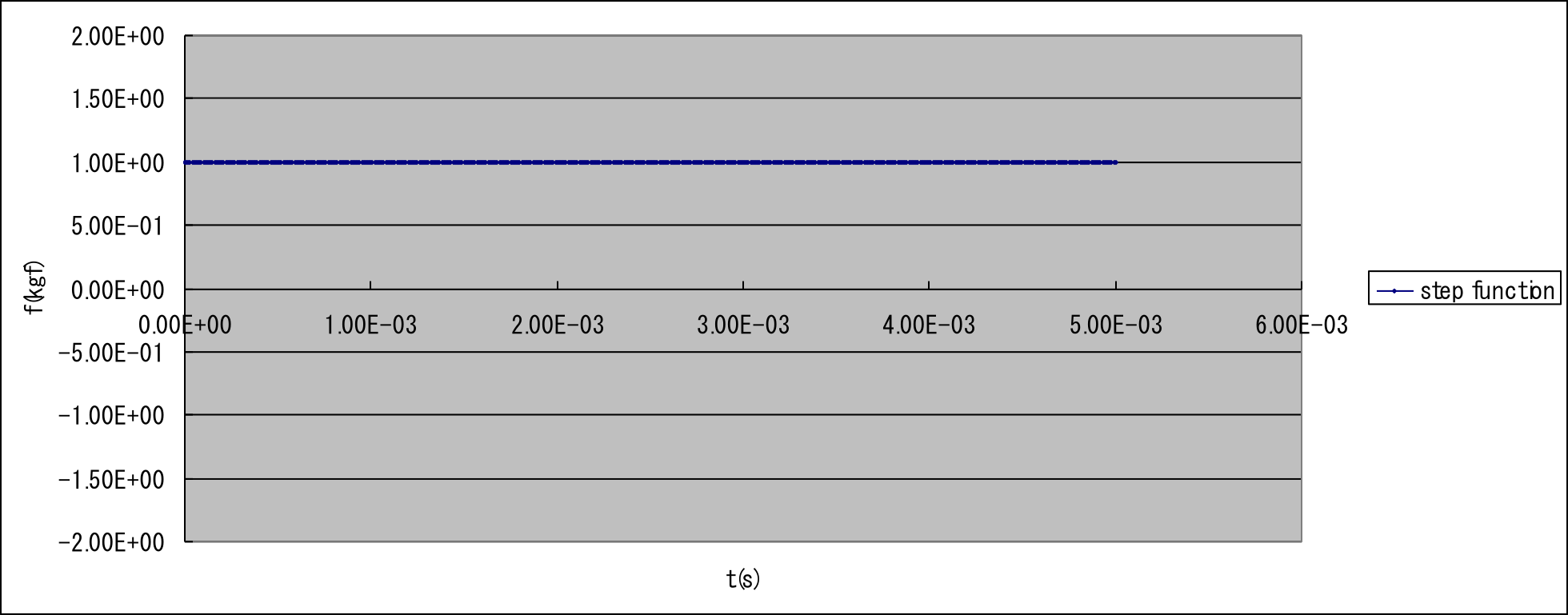
The theoretical solution for vibration point displacement is as follows:
F(t)=F0I(t)
where
F0:Constant vector
I(t)={0,t<0 1,0≤t
u(t)=F0l3EI∞∑_i=11−cosωitλi4{coshλi−cosλi−coshλi+cosλisinλi+sinλi(sinhλi−sinλi)}2
Verification conditions:
| Length | L | 10.0 mm |
| Cross-sectional width | a | 1.0 mm |
| Cross-sectional height | b | 1.0 mm |
| Young's modulus | E | 4000.0 kgf/mm2 |
| Poisson's ratio | ν | 0.3 |
| Density | ρ | 1.0E−09 kgfs2/mm3 |
| Gravitational acceleration | g | 9800.0 mm/s2 |
| External force | F0 | 1.0 kgf |
| Element | Hexahedral linear element |
| Tetrahedral secondary element | |
| Solution | Implicit method |
| Parameter γ of Newmark-β method | 1/2 |
| Parameter β of Newmark-β method | 1/4 |
| Explicit method | |
| Damping | N/A |
| Case Name | Element Type | No. of Nodes | No. of Elements | Solution | Time Increment Δt [sec] |
|---|---|---|---|---|---|
| W361_c0_im_m2_t1 | 361 | 99 | 40 | Implicit method | 1.0E-06 |
| W361_c0_im_m2_t2 | 361 | 99 | 40 | Implicit method | 1.0E-05 |
| W361_c0_im_m2_t3 | 361 | 99 | 40 | Implicit method | 1.0E-04 |
| W361_c0_ex_m2_t1 | 361 | 99 | 40 | Explicit method | 1.0E-08 |
| W361_c0_ex_m2_t2 | 361 | 99 | 40 | Explicit method | 1.0E-07 |
| W361_c0_ex_m2_t3 | 361 | 99 | 40 | Explicit method | 1.0E-06 |
| W342_c0_im_m2_t1 | 342 | 525 | 240 | Implicit method | 1.0E-06 |
| W342_c0_im_m2_t2 | 342 | 525 | 240 | Implicit method | 1.0E-05 |
| W342_c0_im_m2_t3 | 342 | 525 | 240 | Implicit method | 1.0E-04 |
| W342_c0_ex_m2_t1 | 342 | 525 | 240 | Explicit method | 1.0E-08 |
| W342_c0_ex_m2_t2 | 342 | 525 | 240 | Explicit method | 5.0E-08 |
| W342_c0_ex_m2_t3 | 342 | 525 | 240 | Explicit method | 1.0E-07 |
| Case name | Element type | Number of nodes | Number of elements | Solution | z-direction displacement: uz(mm) when time t=0.002(s) | |
|---|---|---|---|---|---|---|
| Theorical solution repeated to sextic equation | FrontISTR | |||||
| W361_c0_im_m2_t1 | 361 | 99 | 40 | Implicit method | 1.9753 | 1.9302 |
| W361_c0_im_m2_t2 | 361 | 99 | 40 | Implicit method | 1.9753 | 1.8686 |
| W361_c0_im_m2_t3 | 361 | 99 | 40 | Implicit method | 1.9753 | 0.3794 |
| W361_c0_ex_m2_t1 | 361 | 99 | 40 | Explicit method | 1.9753 | 1.9302 |
| W361_c0_ex_m2_t2 | 361 | 99 | 40 | Explicit method | 1.9753 | 1.9247 |
| W361_c0_ex_m2_t3 | 361 | 99 | 40 | Explicit method | 1.9753 | Divergence |
| W342_c0_im_m2_t1 | 342 | 525 | 240 | Implicit method | 1.9753 | 1.9431 |
| W342_c0_im_m2_t2 | 342 | 525 | 240 | Implicit method | 1.9753 | 1.8719 |
| W342_c0_im_m2_t3 | 342 | 525 | 240 | Implicit method | 1.9753 | 0.3873 |
| W342_c0_ex_m2_t1 | 342 | 525 | 240 | Explicit method | 1.9753 | 1.9359 |
| W342_c0_ex_m2_t2 | 342 | 525 | 240 | Explicit method | 1.9753 | 1.9358 |
| W342_c0_ex_m2_t3 | 342 | 525 | 240 | Explicit method | 1.9753 | Divergence |

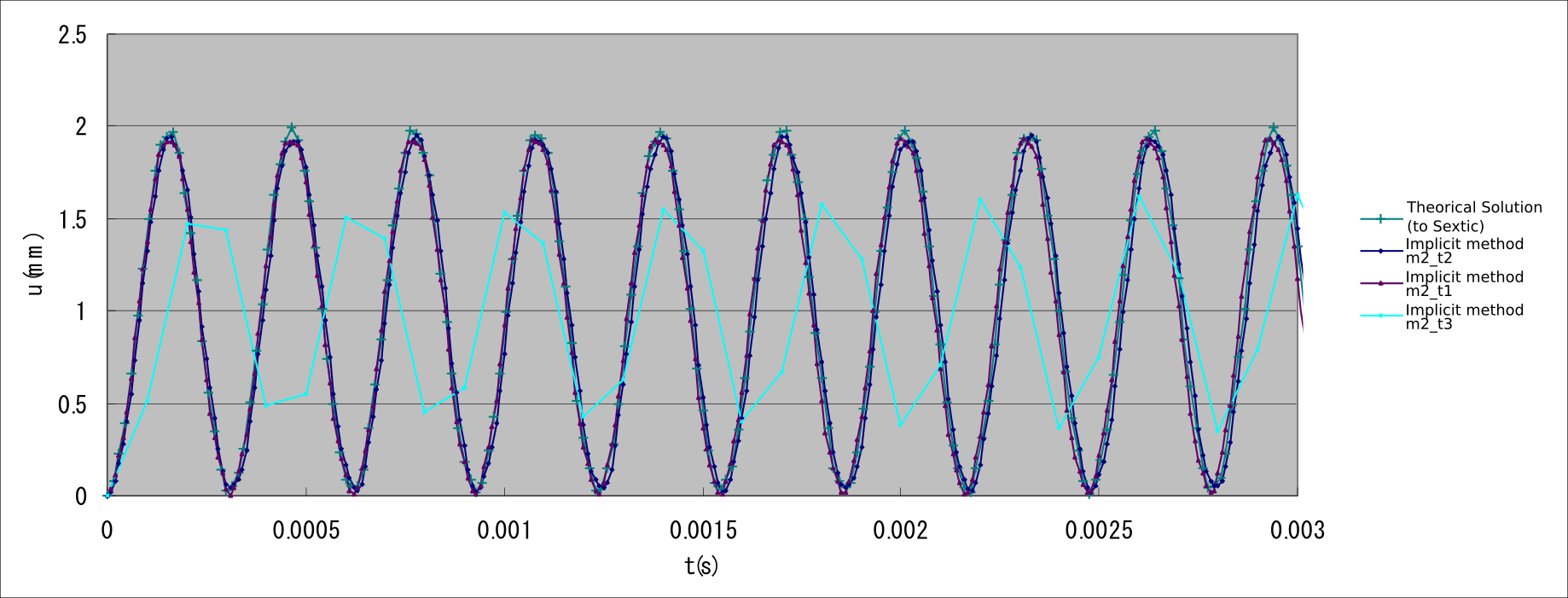

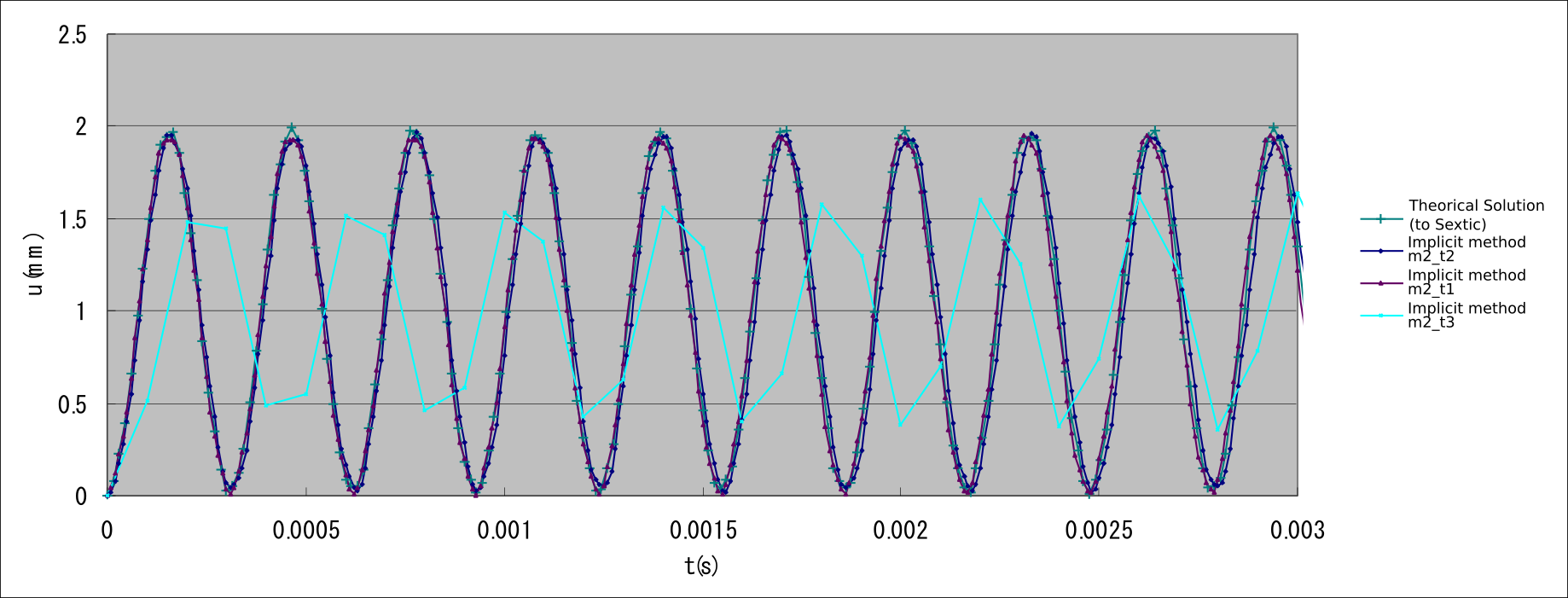
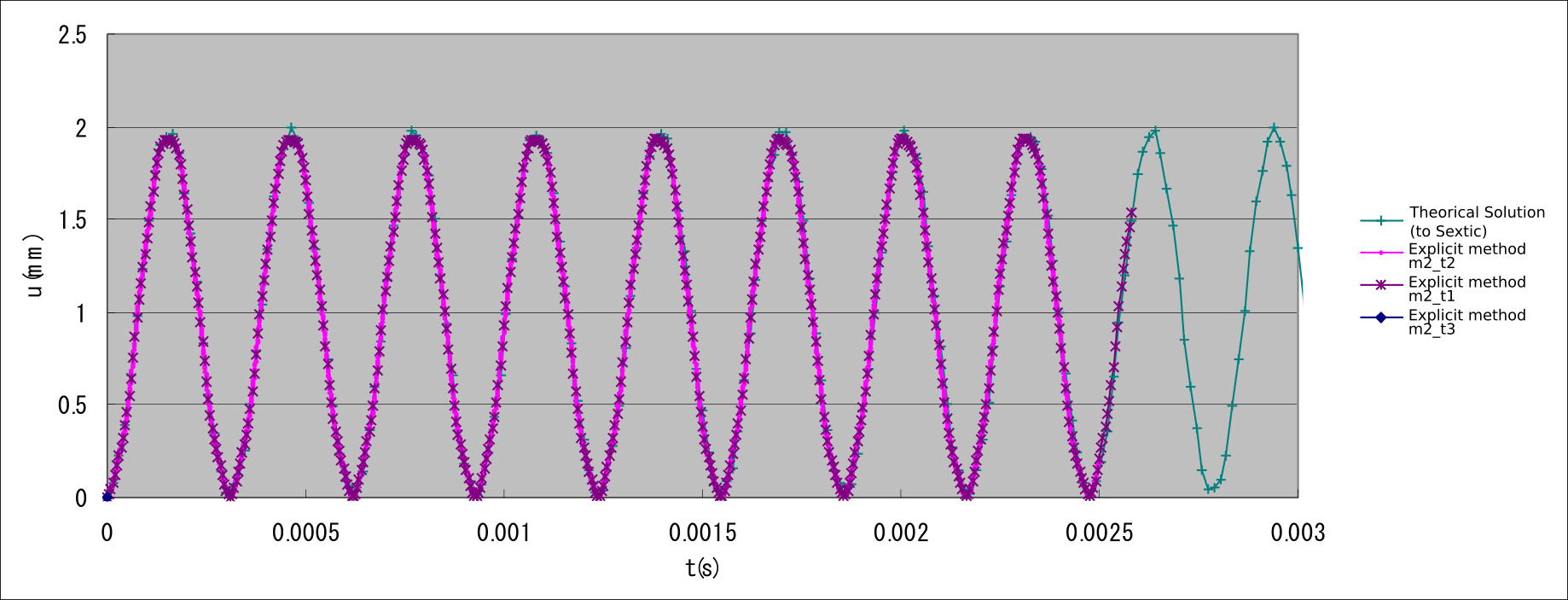
(6) Frequency response analysis
In this verification, a frequency response analysis was performed on a cantilever, and the results were compared with those obtained using the ABAQUS software. The analysis model and verification conditions are presented below:
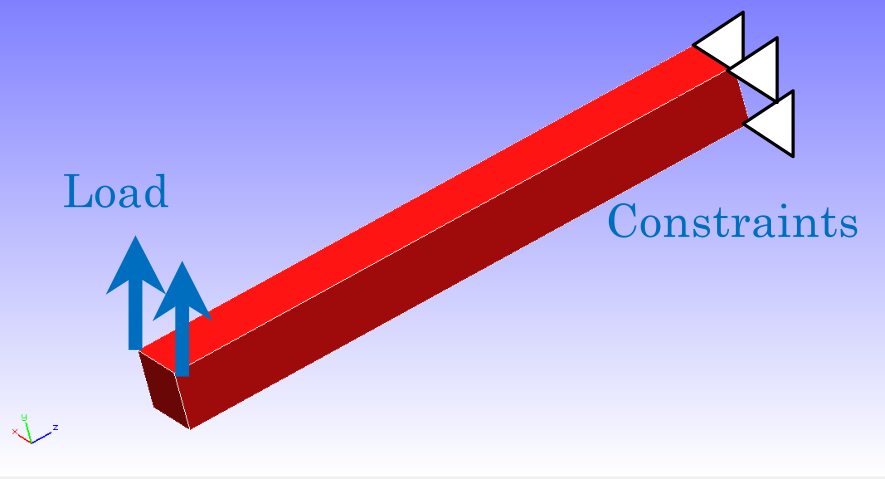
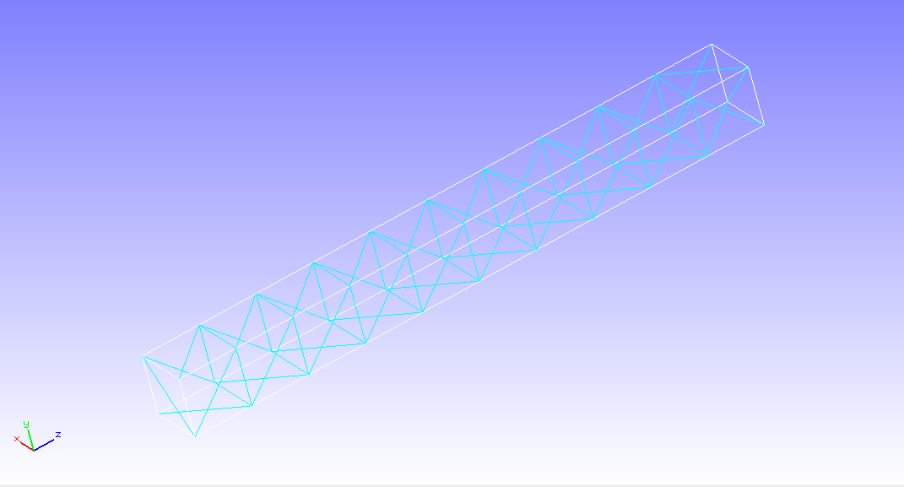
Analysis conditions:
| Young's modulus | E | 210000 N/mm2 |
| Poisson's ratio | ν | 0.3 |
| Density | ρ | 7.89E−09 t/mm3 |
| Gravitational acceleration | g | 9800.0 mm/s2 |
| Load | F0 | 1.0 N |
| Parameter of Rayleigh damping | Rm | 0.0 |
| Parameter of Rayleigh damping | Rk | 7.2E−07 |
The eigenvalues up to the fifth order and the frequency response of the vibration points obtained from eigenvalue analysis are as follows:
| mode | FrontISTR | ABAQUS |
|---|---|---|
| 1 | 14952 | 14952 |
| 2 | 15002 | 15003 |
| 3 | 84604 | 84539 |
| 4 | 84771 | 84697 |
| 5 | 127054 | 126852 |
